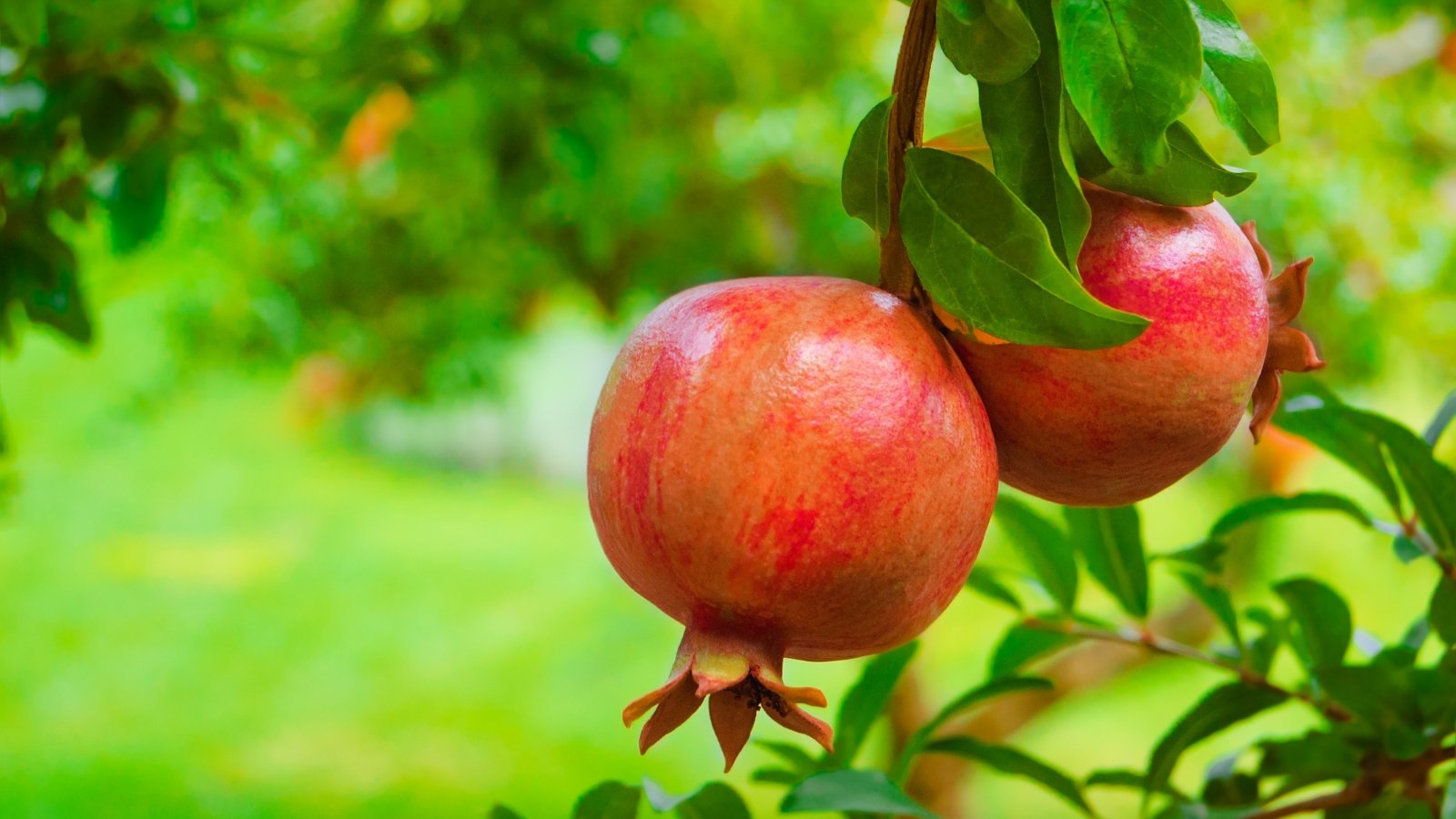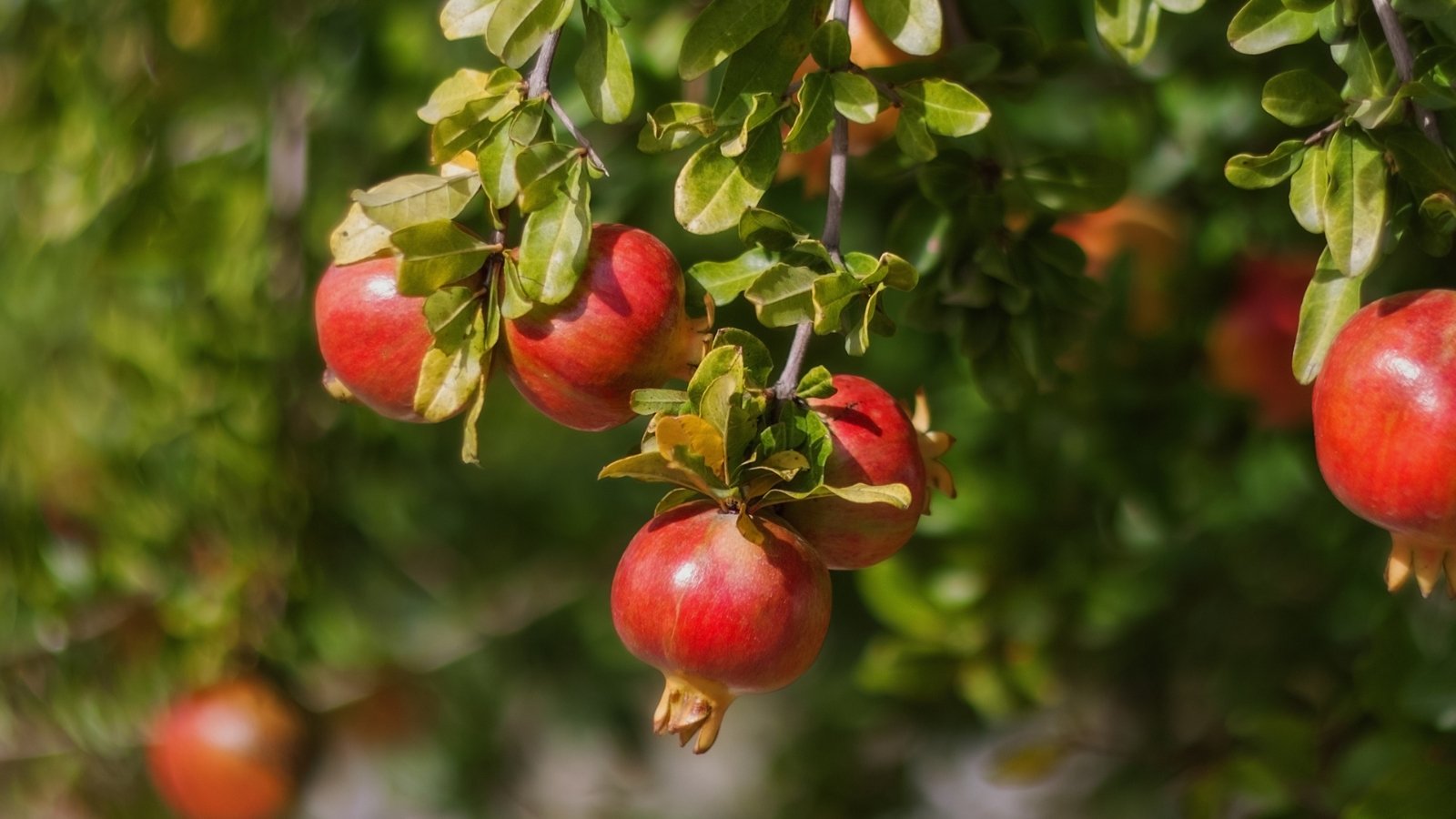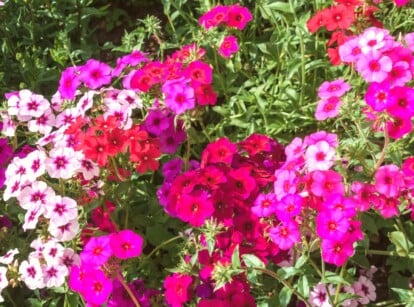9 Best Pomegranate Varieties for Home Gardens
Pomegranates are incredibly low-maintenance, look stunning in the garden, and produce delicious, sweet fruits with a variety of uses. Gardening expert Madison Moulton lists 9 of the best pomegranate varieties for home gardens.

Contents
A staple in trending Mediterranean-inspired or drought-tolerant gardens, pomegranates are one of my favorite fruit trees.
They’re not the first fruit to come to mind – you’d probably think of growing the more common trees like apples or citrus first. However, there are so many benefits to growing pomegranates, from their impressive ornamental value to ease of care.
They are generally better suited to warmer climates that match their native habitats, but there are hardier options for gardeners in cooler regions. Try one of these 9 interesting varieties, and you won’t be disappointed.
Texas Pink

‘Texas Pink’ is known first and foremost for its large fruits. These small trees produce plenty of bright pink, massive fruits filled with tasty arils that are juicy and tart – everything you want from a pomegranate.
But that’s not the only value they offer. You can also enjoy the ornamental red flowers from late spring and into summer, depending on the climate you’re in. And their manageable size also makes them suitable for planting in large containers if you don’t have enough backyard space.
In the right environments, ‘Texas Pink’ is tough and doesn’t encounter many problems. You generally don’t need to worry about pests or diseases, and the tree won’t suffer if you miss a watering or two. Depending on the size of the tree you plant, you may even see fruits its first season.
Eversweet

If you’re not a fan of tart flavors or large, crunchy seeds, ‘Eversweet’ is the pomegranate for you. As the name implies, ‘Eversweet’ produces one of the sweetest pomegranates you can grow. The seeds are also much smaller, meaning there is much more juicy flesh to enjoy.
‘Eversweet’ blossoms are an eye-catching color, appearing in spring and making way for the sought-after fruits. The outer skin of the fruits is a mottled blush-pink or red, perfectly matching the clear arils inside. The transparent color also means you don’t need to worry about any staining with these fruits.
‘Eversweet’ pomegranates perform best in warmer conditions, ideal for USDA Zones 7-10. High temperatures and plenty of sun will deliver the largest possible harvest. Those in cooler regions can consider growing in containers to provide extra warmth and protection when temperatures drop.
Wonderful

‘Wonderful’ is one of the most popular pomegranate varieties for home gardens. It’s also popular among commercial growers, particularly for making juices, thanks to the high water content and impressive flavor of the fruits.
Growing to around 10 feet tall, this dwarf fruit tree is perfect for urban gardens or container growing with some extra maintenance. When you’re not harvesting, you can enjoy the bright flowers and structural shape – a great ornamental tree. They can be grown in a shrub or tree shape, making them a great edible option for hedging or espalier.
Warm climates are essential for fruit ripening. Plant outdoors in USDA Zones 8-11 or in containers if you live in a slightly lower zone. Full sun will also promote strong growth and healthy, productive plants.
Grenada

This sport of ‘Wonderful’ has a slightly earlier ripening time. That makes it ideal for impatient gardeners (myself included) who want to be the first to taste the fruits of the season.
‘Grenada’ fruits are a rich, deep color, with dark red outer skin that looks quite dramatic. They still have the tart finish many love about pomegranates but are generally sweeter than some other varieties. The fruits are perfect for eating fresh, but their sweetness also works well in preserves.
While they don’t require much attention, light maintenance will keep your tree looking its best season after season. Prune in winter to trim the tree into your desired shape and feed annually to replenish soil nutrients.
Sharp Velvet

This is another pomegranate variety with an apt name: ‘Sharp Velvet’. The deep red skin of the fruits opens to reveal rich arils that glisten like royal red velvet. The flavor is equally rich and tart, perfect for topping salads or using in cooking.
Besides flavor, ‘Sharp Velvet’ is also appreciated for its high yield. With just one tree, you’ll get to harvest plenty of fruits, probably more than you can eat yourself in one season. Planting more than one tree will boost your yield even further, thanks to the increase in pollination.
Pomegranate flowers also add ornamental value and a buzz of activity to the garden, attracting pollinators like butterflies and hummingbirds. Plant them in a spot where you can see them from your home to enjoy their beauty from indoors and out.
Sumbar

To add a touch of the Mediteanean to your garden in cooler regions, this variety is ideal. Named after the Sumbar River Valley of Turkmenistan, ‘Sumbar’ handles the cold a little better than other varieties on this list. While they appreciate warmth, the fruits will still ripen reliably in lower zones.
The fruit is sweet but mild, with a soft texture perfect for eating fresh. These pomegranates are also suitable for juicing, with colorful red arils that retain their deep hue. As a bonus, the fruits ripen relatively early and are ready to harvest around September or October.
‘Sumbar’ can tolerate some partial sun, but a full sun position is best for a higher yield. Plant in well-draining soil that matches the sandy Mediterranean conditions they are accustomed to. They can also be planted in pots, as long as the container has drainage holes and is large enough to accommodate the mature size of the tree.
Angel Red

‘Angel Red’ pomegranates are incredibly versatile, not just in the kitchen but also in the garden. The fruits are among the juiciest of all pomegranates, perfect for snacking or juicing. The seeds are also soft and chewable rather than hard and tough for those who like to eat the fruits fresh.
‘Angel Red’ has tons of ornamental value. The fruits are a vivid red, matching the bright blooms that come before them in spring. The tree also has a wonderful shape and ornamental bark that catches the eye no matter where it is planted.
After planting, your ‘Angel Red’ tree will require consistent watering to establish a strong root system. Once established, pomegranates are considered drought-tolerant and won’t require much additional watering, unless there is an extended period with little rainfall.
Parfianka

Known for its large, ruby-red arils that are both juicy and sweet, ‘Parfianka’ is irresistible when eaten fresh or used in cooking. Like all pomegranates, the fruits are packed with antioxidants, supporting health while tasting great at the same time.
‘Parfianka’ reaches a maximum height of 12 feet, having lots of garden presence without taking up too much space. This makes it ideal for smaller backyards as a focal tree or even planted in containers if you’re willing to manage size with regular pruning.
Start harvesting the fruits in fall, perfectly timed for all your holiday season bakes and decorations. When stored correctly, they have quite a long shelf life, lasting well throughout winter. Alternatively, use them in preserves to make the tasty fruits last even longer.
Surh-Anor

‘Surh-Anor’ pomegranates are wonderfully sweet and full of moisture—the perfect variety for pomegranate juice lovers. The skin has a pale reddish hue, and like the ‘Eversweet’ variety, they have clear anils on the inside.
This variety is incredibly resilient, adapting well to tough conditions and requiring little attention once established. The fruits don’t encounter any issues with sun injury in warmer regions, and they can manage in slightly cooler regions, too, as long as they are planted in the brightest and warmest possible spot.
To add to their resilience, mature ‘Surh-Anor’ trees are considered drought-tolerant, although they will need regular watering soon after planting to establish a strong root system. You also don’t have to worry about pruning if you’re happy to let them grow naturally, but pruning can be used to control sizes in smaller gardens.
Final Thoughts
If you want to grow a fruit tree with ornamental value, delicious fruits, and a manageable size, you can’t go wrong with these pomegranate varieties.









